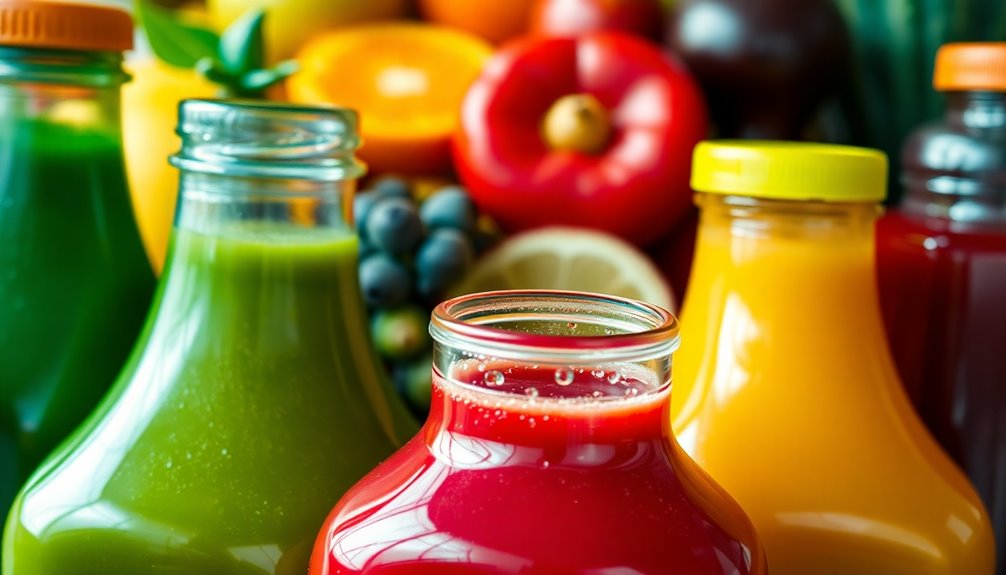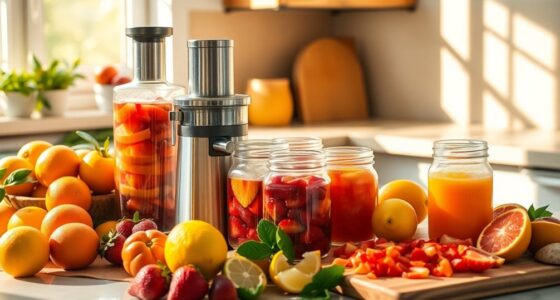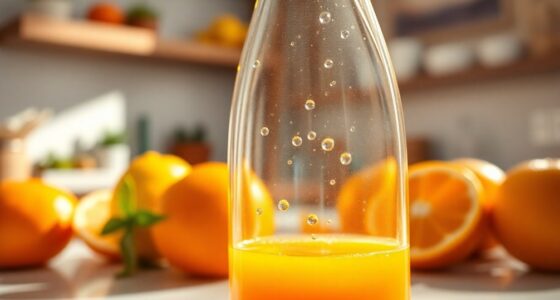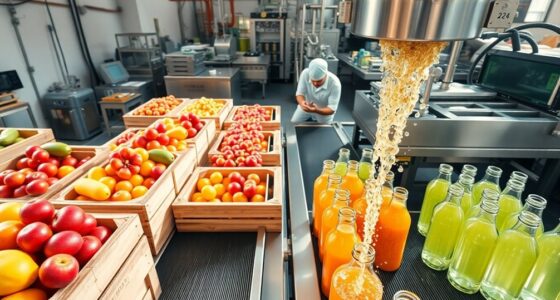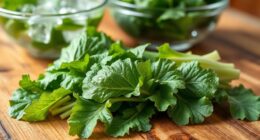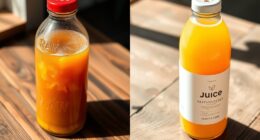Juice packaging plays a crucial role in keeping your drink fresh longer. It acts as a shield against air, light, and moisture, preventing spoilage. Technologies like high-pressure processing eliminate harmful germs while maintaining flavor, extending shelf life for weeks. Sustainable options appeal to eco-conscious consumers, enhancing brand loyalty. By storing juices correctly, you can further preserve their quality at home. Discover more about how packaging choices can impact your juice experience!
Key Takeaways
- Effective packaging acts as a barrier against air, light, moisture, and dirt, preserving juice freshness and extending shelf life.
- Aseptic packaging keeps juices shelf-stable for months by preventing spoilage from microorganisms.
- High-Pressure Processing (HPP) eliminates harmful microbes while maintaining flavor, extending refrigerated shelf life to 30-45 days.
- Opaque containers protect light-sensitive juices, preserving their nutritional quality and flavor integrity.
- Sustainable packaging options enhance brand image and customer loyalty while minimizing environmental impact.
The Importance of Packaging in Juice Preservation
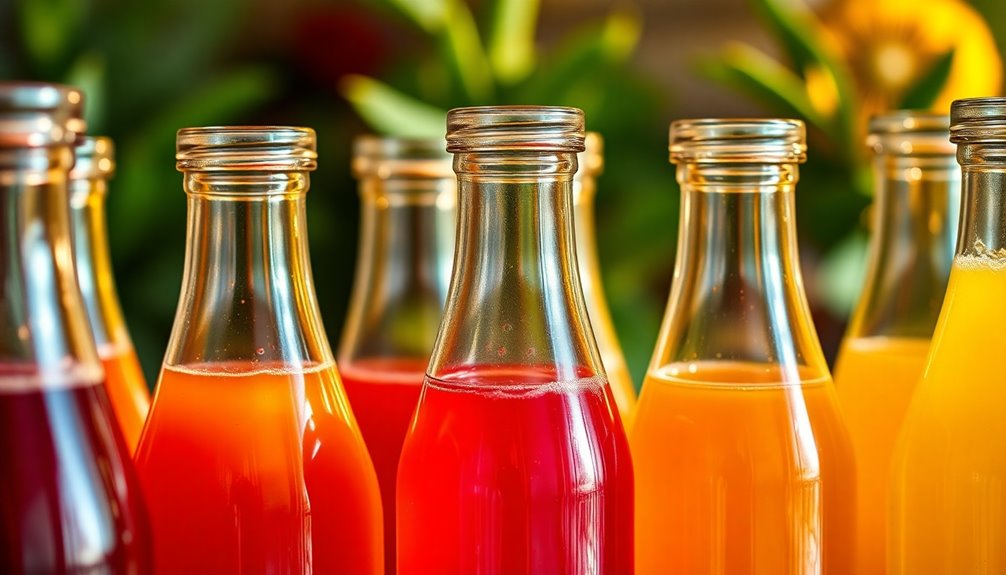
When you grab a bottle of juice, you mightn't realize that effective packaging plays an important role in keeping it fresh.
Juice packaging acts as a protective barrier against air, light, moisture, and dirt, which can spoil the product and reduce its quality. Advanced technology, like high-quality seals and automatic bottle cappers, prevents souring and bacterial growth, ensuring the juice's safety and freshness.
Sustainable packaging options, such as recyclable materials, not only preserve juice quality but also showcase a brand's commitment to the environment.
Additionally, user-friendly designs with resealable and spill-proof features enhance convenience, encouraging repeat purchases.
In short, effective packaging is vital for maximizing shelf life while maintaining the freshness and integrity of your favorite juice.
Understanding Different Types of Juice Packaging
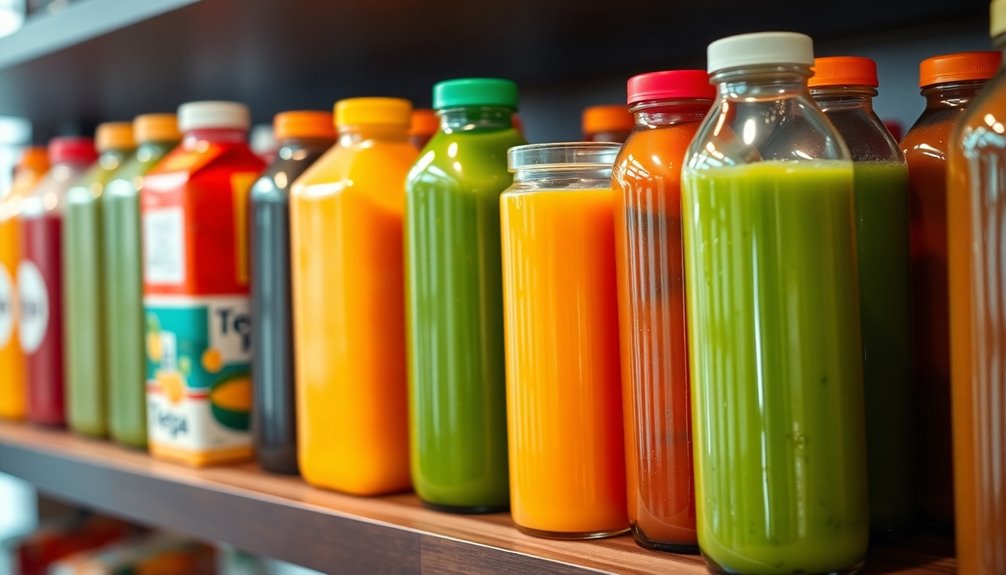
While exploring juice packaging options, you’ll find that various materials and designs cater to different needs and preferences. The right juice packaging plays a crucial role in maintaining freshness and extending shelf life. Additionally, selecting the appropriate packaging can significantly impact the consumer’s experience, as it not only influences the aesthetic appeal but also the convenience of use. Many brands now prioritize eco-friendly options, integrating sustainability with functionality. Ultimately, when considering juice storage solutions for freshness, it’s essential to balance practicality with design to enhance both preservation and marketability.
- Aseptic packaging allows juices to remain shelf-stable for months.
- Opaque containers shield light-sensitive juices, preserving their nutritional quality.
- High-quality seals prevent bacteria growth, keeping your juice safe and flavorful.
- Innovative designs, like resealable and spill-proof options, enhance convenience after opening.
Incorporating juices with high fiber content can also contribute to digestive health, making it a perfect complement to your diet.
Understanding these packaging types helps you choose the best option for your lifestyle, ensuring you enjoy your juice at its freshest while benefiting from effective preservation techniques.
How High-Pressure Processing Enhances Shelf Life
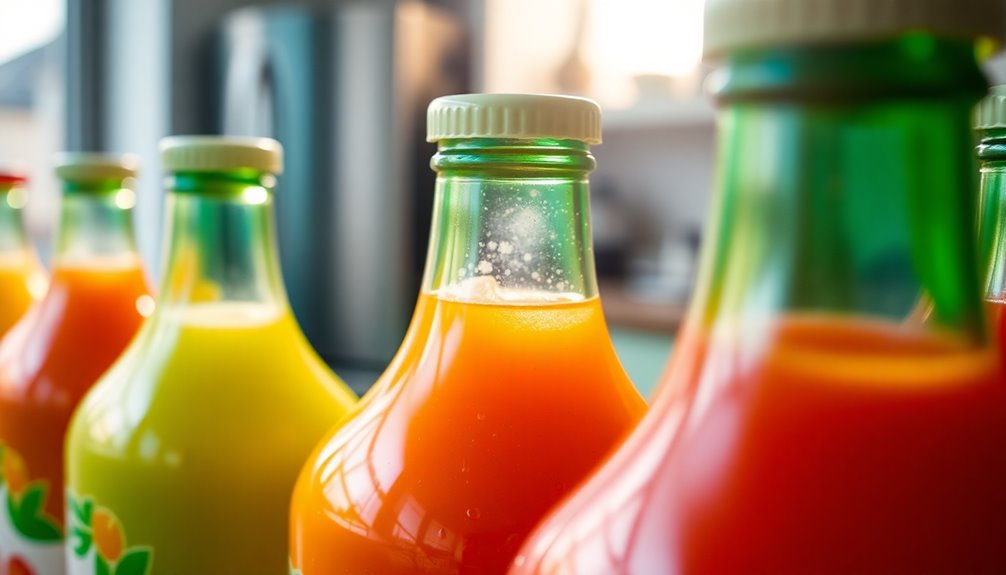
High-Pressure Processing (HPP) offers a revolutionary way to enhance juice shelf life by using extreme pressure to eliminate harmful microbes without heat.
By subjecting bottled juice to pressures up to 85,000 PSI, HPP effectively removes microorganisms present while preserving the nutritional content and flavor.
This non-thermal method allows fresh juice to last considerably longer, extending shelf life to 30-45 days when refrigerated, compared to just 2-3 days for raw, unprocessed juices.
After HPP, the quality remains intact, maintaining the fresh taste that customers love.
The FDA mandates that juices sold in supermarkets must undergo HPP or pasteurization for safety, ensuring your cold-pressed juice is both delicious and safe, enhancing overall customer satisfaction. Additionally, juices rich in vitamins A, C, and E can further promote health benefits, making them an excellent choice for consumers.
Sustainable Packaging Solutions for Juice Products
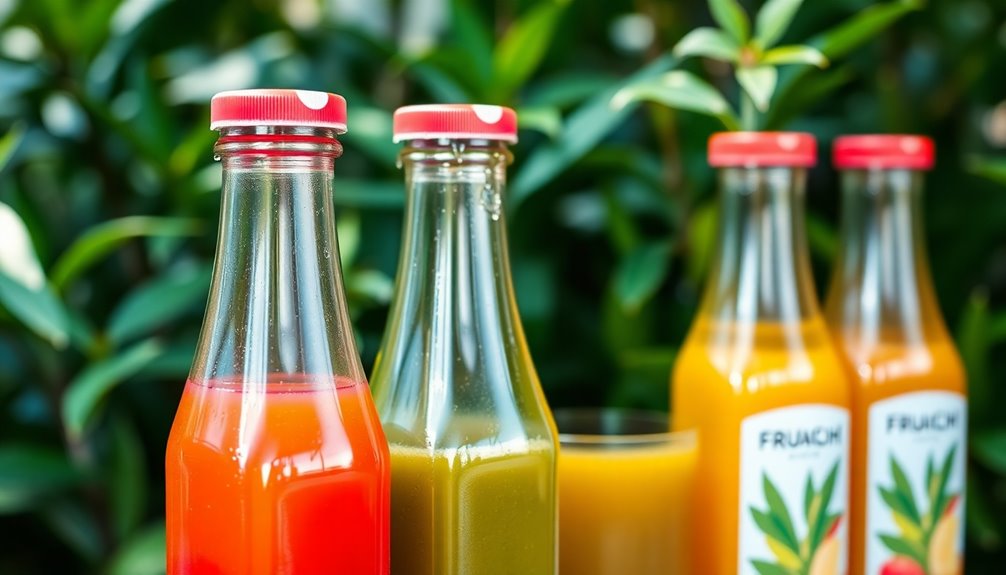
As consumers increasingly seek eco-friendly options, sustainable packaging solutions for juice products have become essential for brands aiming to reduce their environmental impact.
By embracing sustainable packaging, you're not just meeting consumer demand but also enhancing the shelf life and safety of fresh juice.
- Use biodegradable materials to lessen landfill waste.
- Lightweight packaging minimizes carbon emissions during transport.
- Advanced liquid packaging protects against air and moisture, reducing spoilage.
- Eco-friendly options foster trust and loyalty among environmentally conscious consumers.
These practices not only reflect a brand's commitment to sustainability but also position it competitively in the market.
Best Practices for Storing Fresh Juice at Home
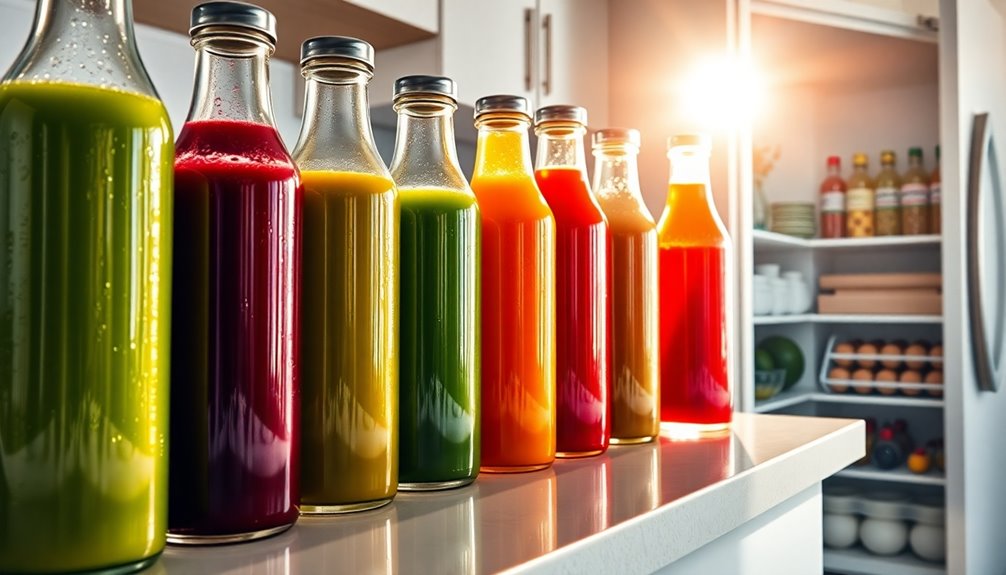
Storing fresh juice properly is essential for maintaining its flavor and nutritional benefits. To maximize its shelf life, use airtight glass containers to minimize air exposure, which can compromise quality and freshness.
Always label your containers with the date they were made; most juices last 1-5 days. Place your juice in the coldest part of the refrigerator, ideally between 32°F-40°F, avoiding door shelves where temperatures fluctuate.
Fill containers to the brim to limit air contact, helping your juice stay fresh longer. For an added boost, consider mixing in lemon juice, as its acidity can naturally extend the shelf life of other juices. Additionally, incorporating healthy fruit juice varieties can enhance flavors while providing essential nutrients.
Frequently Asked Questions
How to Increase the Shelf Life of Fresh Juice?
To increase the shelf life of your fresh juice, use airtight glass containers to minimize air exposure.
Store it in the coldest part of your fridge, ideally between 32°F-40°F.
Consider cold-pressing your juice or using High Pressure Processing to eliminate harmful microbes.
Adding natural preservatives like lemon juice can also help.
Finally, label your containers with the production date to keep track of freshness and encourage timely consumption.
What Is the Shelf Life of Packed Juice?
The shelf life of packed juice varies widely.
For instance, pasteurized juice typically lasts 7-10 days, while unpasteurized juice only sticks around for 2-3 days.
If you're opting for cold-pressed juices, expect freshness for about 3-5 days.
Grocery store juices processed with High-Pressure Processing (HPP) can last up to 30-45 days.
What Makes Juice Last Longer?
To keep your juice as fresh as a morning breeze, focus on its packaging. Airtight glass containers are your best friends, locking out air and preserving flavor.
If you opt for High-Pressure Processing, you'll extend its life to 30-45 days, ensuring every sip bursts with nutrition.
Don't forget opaque packaging—it shields your juice from light, maintaining its vibrant taste.
What Juices Have the Longest Shelf Life?
If you're looking for juices with the longest shelf life, go for those that are pasteurized or processed with High Pressure Processing (HPP).
These can last 30-45 days when stored properly. Citrus juices like lemon and orange can also last 3-5 days, while carrot juice holds up similarly.
Remember to store all juices in airtight containers and keep them refrigerated to maximize freshness and reduce spoilage.
Enjoy your juice without worrying too much about it going bad!
Conclusion
So, if you thought the secret to fresh juice was just picking up a pretty bottle, think again! The right packaging isn't just a fashion statement—it's your juice's best friend. With some high-pressure magic and a dash of sustainability, you can sip on that juice without worrying about it turning into a science experiment overnight. Remember, folks, even juice needs a decent home. Store it right, and you won't have to share it with the moldy monsters lurking in your fridge!
Cindy thoroughly researches juicing trends, techniques, and recipes to provide readers with practical advice and inspiration. Her writing style is accessible, engaging, and designed to make complex concepts easy to understand. Cindy’s dedication to promoting the advantages of juicing shines through her work, empowering readers to make positive changes in their lives through the simple act of juicing.

